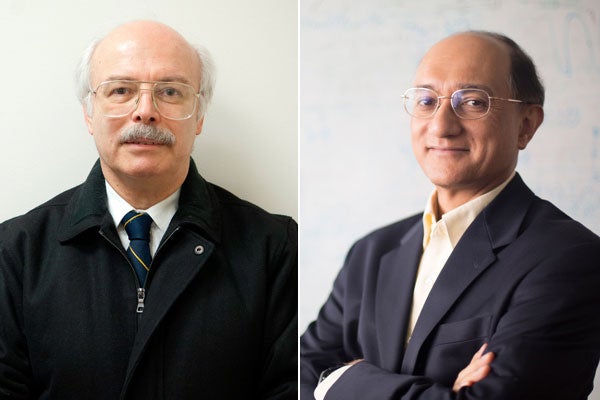
2014 Killam Prize winners: Andreas Mandelis and Sajeev John
Published: April 9, 2014
Two University of Toronto researchers – physicist Sajeev John and engineer Andreas Mandelis – have each won a 2014 Killam Prize, one of Canada’s most prestigious scholarly awards.
The Killam Prize recognizes outstanding career achievement by scholars actively engaged in research. Administered by the Canada Council for the Arts, only five prizes are awarded annually and each comes with a $100,000 prize.
Professor John, from the Faculty of Arts and Science, is being recognized for his ground-breaking work on the localization of light and the invention and development of what are known as new Photonic Band Gap (PBG) materials.
“Trapping light fascinated me as student at Harvard,” said John. “No one else believed it was possible at the time, but I felt it was very fundamental and could have major consequences. When the 'photonic band gap' concept dawned in my mind, I realized the dream could come true."
His leading research, in which the flow of light is manipulated in much the same way that electricity is steered through micro-electronic circuits, may enable the development of photonic computers using laser light to carry information instead of electric current. The result? Faster, less expensive and more versatile tools in the computer and telecommunications industries.
Other applications include novel fibres for laser surgery and light-trapping in thin films for efficient solar energy harvesting.
Professor Mandelis combines applied physics and engineering for entirely new applications of lasers in materials science and biomedical engineering. His current research involves creating new tools that use light for the non-invasive diagnosis and management of diseases such as cancer and diabetes.
"Being able to do the science is very important to me, while at the same time applying engineering principles and seeing it materialize in new technology for areas that need it, like breast cancer tumour detection,” said Mandelis.
From U of T’s Faculty of Applied Science and Engineering, Mandelis is a world leader in the field of diffusion-wave and photo-acoustic sciences. He is also developing more efficient methods of quality control in the manufacturing and use of optoelectronics, metals and coatings.
“Both of these scientists are conducting research that has a clear and very positive impact on society today,” said Professor Paul Young, U of T’s vice-president, research and innovation.“By awarding the Killam Prize to Sajeev and Andreas, the Canada Council is recognizing decades of research, innovation and commitment on both their parts.
“This is a great day for them and for U of T.”
John’s theoretical framework for light localization PBG materials was laid out in his Harvard PhD thesis in 1984 and further refined through the conception of PBG materials in 1987 while he was an assistant professor of theoretical physics at Princeton. Theory became reality over the next two decades in major laboratories around the world. After joining U of T in 1989, John began working with U of T chemistry professor Geoffrey Ozin, U of T physicist Henry van Driel and a team of scientists from Spain to build the first self-assembled silicon-based PBG material in 2000. Since then, John and fellow researchers have refined theory and technique to create PBG materials that are easier and cheaper to manufacture.
The field of "photonic crystals" has surpassed all expectations, said John.
“It allows us to tailor the fundamental electromagnetic force. It enables micro-manipulation of laser light for optical computing, trapping of sunlight for thin film solar cells, and localization of light for medical diagnostics and therapy. The future looks bright for the control of light.”
Professor Mandelis’ groundbreaking research puts him at the intersection between the exciting fields of engineering and applied physics – a combination that attracted him because of its wide potential for application. By blending these two research fields, Mandelis and his team are able to see small differences in the human body or manufacturing materials that have gone previously undetected.
“For example, when a tumour starts to grow, it is accompanied by the growth of new blood vessels,” he explained. “Lasers can spot these blood vessels earlier than ultrasound machines because blood absorbs light differently.
“This allows for earlier detection of tumours.”
The director for advanced diffusion-wave technologies in the Department of Mechanical and Industrial Engineering, Mandelis is also cross-appointed to the Institute for Biomaterials and Biomedical Engineering and The Edward S. Rogers Sr. Department of Electrical & Computer Engineering.
Previous U of T Killam recipients include computer scientist Geoffrey Hinton, physicist Richard Peltier and linguist Keren Rice.


